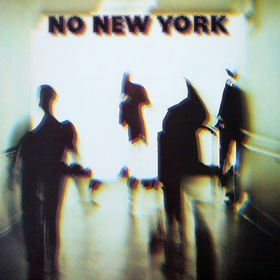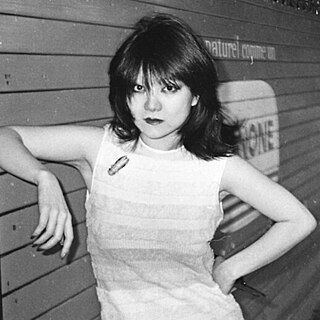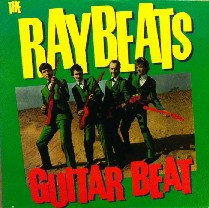Related Research Articles
No wave was an avant-garde music genre and visual art scene which emerged in the late 1970s in Downtown New York City. The term was a pun based on the rejection of commercial new wave music. Reacting against punk rock's recycling of rock and roll clichés, no wave musicians instead experimented with noise, dissonance, and atonality, as well as non-rock genres like free jazz, funk, and disco. The scene often reflected an abrasive, confrontational, and nihilistic world view.
DNA was an American no wave band formed in 1977 by guitarist Arto Lindsay and keyboardist Robin Crutchfield, and later joined by drummer Ikue Mori and bassist Tim Wright. They were associated with the late 1970s New York no wave scene, and were featured on the 1978 compilation No New York.

James Chance, also known as James White, is an American saxophonist, keyboard player, and singer.

Teenage Jesus and the Jerks were an influential American no wave band, based in New York City, who formed part of the city's no wave movement.

Lydia Lunch is an American singer, poet, writer, actress and self-empowerment speaker. Her career began during the 1970s New York City no wave scene as the singer and guitarist of Teenage Jesus and the Jerks.

James Chance and the Contortions was a musical group led by saxophonist and vocalist James Chance, formed in 1977. They were a central act of New York City's downtown no wave music scene in the late 1970s, and were featured on the influential compilation No New York (1978).

No New York is a No Wave compilation album released in 1978 by record label Antilles under the curation of producer Brian Eno. Although it only contains songs by four different artists, it has been considered important in defining and documenting the scene and movement, with the name "no wave" being influenced by that of the album according to some accounts.
Bush Tetras are an American post-punk No Wave band from New York City, formed in 1979. They are best known for the 1980 song "Too Many Creeps", which exemplified the band's sound of "jagged rhythms, slicing guitars, and sniping vocals". Although they did not achieve mainstream success, the Bush Tetras were influential and popular in the Manhattan club scene and college radio in the early 1980s. New York's post-punk revival of the 2000s was accompanied by a resurgence of interest in the genre, with the Tetras' influence heard in many of that scene's bands.
No wave cinema was an underground filmmaking movement that flourished on the Lower East Side of New York City from about 1976 to 1985. Associated with the artists’ group Collaborative Projects, no wave cinema was a stripped-down style of guerrilla filmmaking that emphasized dark edgy mood and unrehearsed immediacy above many other artistic concerns – similar to the parallel no wave music movement in its raw and rapid style.
8 Eyed Spy was an American no wave band from New York City, consisting of Lydia Lunch and Jim Sclavunos, Michael Paumgardhen, Pat Irwin and George Scott III. The group was active from 1979 to 1980.

Anya Phillips was a Taiwanese fashion designer and the co-founder of the New York nightclub the Mudd Club. Phillips influenced the fashion, sound, and look of the New York-based no wave scene of the late 1970s. She was also the manager and girlfriend of musician James Chance.
Pat Irwin is an American composer and musician who was a founding member of two bands that grew out of New York City's No Wave scene in the late 1970s, the Raybeats and 8-Eyed Spy. He joined The B-52s from 1989 through 2008. He currently performs and records with SUSS who have released several records on the indie label Northern Spy.
The Raybeats were an American instrumental neo-surf rock combo from New York City that arose from the No Wave musical scene. The original line-up consisted of Don Christensen (drums), Jody Harris (guitar), Pat Irwin, and George Scott III (bass).
Jody Harris is an American guitarist, singer, songwriter and composer who was born in Kansas and became a central figure in the seminal no wave scene in New York City in the 1970s.

Buy is the debut studio album by American no wave band Contortions. It was released in 1979 through ZE Records following the band's inclusion on the 1978 compilation No New York.

Off White is a 1979 album by American no wave band James White and the Blacks.
Human Switchboard was an American punk rock band formed in Cleveland, Ohio in 1977. According to a Rolling Stone review, Human Switchboard "was of its time — mixing Velvet Underground guitar churn, Sixties garage-rock organ, rubbery Pere Ubu-like baselines, skronky sax and athletically spazzy drumming."

Guitar Beat is the debut album by the neo-surf band the Raybeats. It was released in 1981 and produced by Martin Rushent. The album features ten original instrumentals, plus a Jan and Dean cover.
Boris Policeband was a no wave noise music performer who used dissonant violin, police radio transmissions, and voice. Boris Pearlman was a classically trained violist from New York City.
Pat Place is an American artist, photographer, and musician noted for her work as a founding member and guitarist of no wave bands James Chance and the Contortions and Bush Tetras.
References
This article includes a list of general references, but it lacks sufficient corresponding inline citations .(July 2010) |
- ↑ Boch, Richard (2017). The Mudd Club. Port Townsend, WA: Feral House. p. 365. ISBN 978-1-62731-051-2. OCLC 972429558.
{{cite book}}: CS1 maint: date and year (link) - ↑ Cohan, Brad (December 28, 2011). "The Story Behind 1970s-era NYC Proto Punks Jack Ruby". Village Voice. Retrieved December 29, 2011.
- ↑ Cohan, Brad (December 28, 2011). "Q&A: Proto-Punks Jack Ruby And No Wave Goddess Lydia Lunch on Finding the Lost Tapes and Remembering Boris Policeband and The Contortions' George Scott". Village Voice (blogs). Retrieved December 29, 2011.
- ↑ "Vital Reissues". Billboard . Vol. 109, no. 17. April 26, 1997. p. 72.